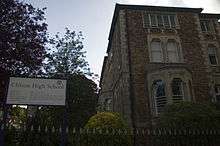Clifton High School, Bristol
 | |
| Established | 1877 |
|---|---|
| Type | Independent day |
| Religion | Church of England |
| Head | Alison Neill |
| Chair of Governors | James Caddy |
| Location |
College Road Clifton Bristol BS8 3JD England 51°16′23″N 2°22′17″W / 51.2731°N 2.3713°WCoordinates: 51°16′23″N 2°22′17″W / 51.2731°N 2.3713°W |
| DfE URN | 109335 Tables |
| Capacity | 650 |
| Students | 598 |
| Gender | Mixed |
| Ages | 3–18 |
| Houses | 4 |
| Colours | Blue, Red |
| Website |
www |
Clifton High School is a co-educational independent school in Clifton, Bristol, England. The school is the only one in the region to operate the Diamond Edge model of education. This model means boys and girls are educated together from Nursery to Year 6, then separately in some subjects between Years 7 and 9. In Years 7 to 9 boys and girls are taught separately for English, Mathematics, IT, Biology, Chemistry, Physics and Games. They are then taught together in all subjects from Years 10 to 13. Clifton High School was founded as a girls' school as the nearby Clifton College was then a boys' school. It became coeducational in 2009. It is a member of the Society of Heads.
History
Clifton High School for Girls was founded in 1877 (after some opposition from nearby Bristol Grammar School)[1] by visionaries including John Percival (bishop), the first Headmaster of Clifton College.[2] The Sixth Form began accepting boys in 2008 and the school became fully coeducational the following year.
Houses
In the 1950s and 1960s the houses were named after the school's founders and early benefactors: Budgett, Percival, Pope, Pears, Winkworth and Wollaston, to whose memory prayers were dedicated on Rose Day (e.g. "Remembering especially Sarah Constance Wollaston"). Later they were named after famous women: Austen (pink), Curie (yellow) and Odette (green). The house names were then changed in academic year 2009-2010 to Holmes, Radcliffe and Redgrave; as this was the first year allowing boys throughout the entire school, the school didn't want entirely female houses. The house names were changed back in academic year 2010-2011, following a competition, to the names of the school founders, Wollaston (yellow), Winkworth (red), Pears (blue) and Percival (green).
Activities
The school focuses on opportunities in music, art and drama, offering concerts, art exhibitions and productions and has a number of special events each year, including:
- "Marquee Week"; A week of celebration centered around a theme such as "Space" or "Nature".
- The School Production, a large theater performance aimed at Senior School Pupils
- The School Carol Service, most recently held in Clifton Cathedral, near the end of the Christmas term.
- "Rose Day", is held in Bristol Cathedral. Hundreds of people attend and prizes are awarded during the service.
Facilities
School facilities include a sports centre, swimming pool, multimedia language centre and several information technology rooms. The school owns the Coombe Dingle Sports Centre in partnership with the University of Bristol which has facilities including lacrosse, rugby and football pitches, and indoor and outdoor tennis courts.
Notable former pupils
- Caroline Bammel, ecclesiastical historian
- Jo Durie, professional tennis player
- Margaret Irwin, novelist
- Melanie Johnson, Labour politician
- Mary Lobel, historian
- Dame Eileen Mayo, artist and designer
- Mary Renault, writer
- Jane Shepherdson, businesswoman
- Hilary Spurling, writer
References
- ↑ John Roach -. Secondary Education in England, 1870-1902. pp. 47–49.
- ↑ "Percival, John (1834 – 1918), headmaster and bishop of Hereford". Oxford Dictionary of National Biography (online ed.). Oxford University Press. doi:10.1093/ref:odnb/35471. (Subscription or UK public library membership required.)